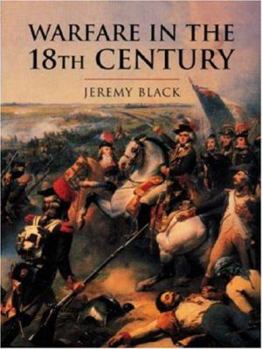Warfare in the 18th Century
(Part of the Cassell History of Warfare Series)
Select Format
Select Condition 
Book Overview
Worldwide warfare might seem like a twentieth-century development, but the colonial empires of Europe fought wars around the globe in the eighteenth. With domains spreading to the Americas and across... This description may be from another edition of this product.
Format:Hardcover
Language:English
ISBN:0304352454
ISBN13:9780304352456
Release Date:January 1999
Publisher:Cassell
Length:224 Pages
Weight:2.30 lbs.
Dimensions:1.0" x 8.1" x 10.7"
Customer Reviews
2 ratings
Warfare in the 18th Century
Published by Thriftbooks.com User , 15 years ago
A good summary of the global wars and military situations of the 1700's, excellent for students or those only casually interested in the subject. I found the author's deliberate (and politically correct) focus on the wider world (as opposed to just Europe and America) informative but also a little annoying. And a warning to potential buyers - there is a book out there with this same title and author, in a series called `Cassel's History of Warfare', that is the exact same title just a different cover, so if you already have one of these books don't buy the other!
A good try at a difficult topic
Published by Thriftbooks.com User , 24 years ago
Jeremy Black wrote this work as part of the Cassell History of Warfare series edited by John Keegan. Unlike the other historians in the series who were assigned specific wars (i.e. WWI, WWII, American Civil War) or types of war (i.e. War in the Air 1914-1945, Napoleonic Wars) he had to cover a whole century on a global scale. He tackled this in an interesting fashion. Rather than focusing on battles or wars as many of his predecessors had done in their sweeping works (JFC Fuller's Military History, etc.) He tried to take a mixed strategy. He first looks at the nature warfare among the different civilizations. He organizes the first three chapters along these lines: 1. War without Europeans, 2. Europeans versus Non-Europeans, 3. Transoceanic Conflict between Europeans. The remaining chapters deal with the American Revolution (a global war), wars within Europe, the importance of naval warfare - which allowed nations to fight on a global scale, and the developing background for Napoleonic innovations. It is admittedly still eurocentric, but Black acknowledges this and still does provide one of the few popular descriptions of warfare outside of Europe for this time period. It should give the reader a curiosity to read more. His bibliography is quite good, although more academic - and deserves attention by the reader. The 2nd and 3rd chapters give credence to the notion that perhaps the first "world war" was actually fought by the French and English empires of the 18th century (by Barbara Tuchman?). Though the armies were not always large, operations were planned and mounted around the globe. The text does read smoothly and there are several nice illustrations and maps. It is not without some faults as noted by the other reviewers, but the author should be given credit for the "degree of difficulty" of his task. It is a good addition to the libraries of military history buffs who are interested in the horse and musket era. It isn't for the specialist American Revolution reader - not enough depth, but for those who are curious about that era, it will open your mind to considering that grand plans were plotted out in an era where it took weeks to months to position an army or fleet for operations.






